28.06.2021
China releases videos of its Zhurong Mars rover

China's space agency has released video of its Zhurong rover trundling across the surface of Mars.
The pictures were acquired by a wireless camera that the robot had placed on the ground.
The new media release also includes sequences from Zhurong's landing in May, showing the deployment of its parachute system and the moment of touchdown.
The six-wheeled robot is investigating a region known as Utopia Planitia.
The China National Space Agency (CNSA) says Zhurong has driven 236m in 42 Mars sols (as of 27 June). A sol is a Martian day. It lasts slightly longer than an Earth day, at 24 hours and 39 minutes.

The latest movies were relayed back to Earth via the Tianwen-1 satellite which orbits the Red Planet.
"The orbiter and the Mars rover are in good working condition, reporting safely from Mars to the party and the motherland, and sending distant blessings on the century of the party's founding," a CNSA press statement said.
The first of July will mark the 100th anniversary of the founding of the Chinese Communist Party.
A video release was expected, especially of the landing, which occurred on 14 May. Some preview stills looking up at the parachute system from the rover's entry capsule were handed out last week.
In the movie version, however, we see the envelope inflate in the rarefied Martian atmosphere. We also see Zhurong and its landing platform drop away from the "backshell" of the capsule; and finally a look-down camera captures the moment of touchdown as the platform's braking rocket motor blasts the surface clear of dust.
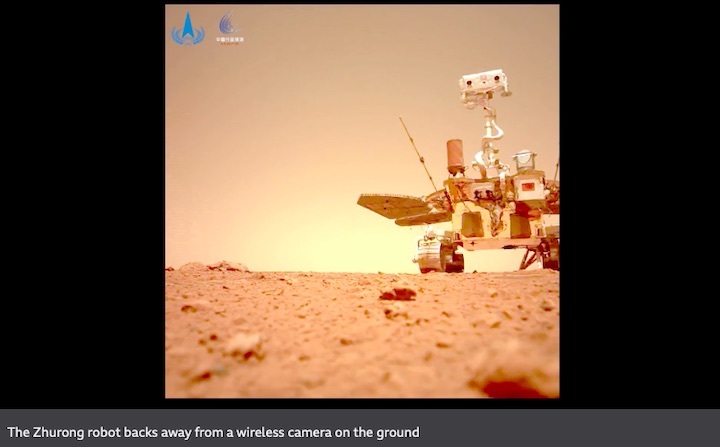
There are three videos on the surface. The first, presumably taken shortly after Zhurong put the wireless camera on the ground, shows the robot backing away.
The second video shows Zhurong wiggling its wheels while sitting next to its landing platform. The CNSA had previously released a still from this scene.
And, finally, the third video details the rover's roll down the ramp that got it off the landing platform on to the surface. What's interesting about this movie is that we get sound as well. We can hear the robot's locomotion system in action.
The nature of Mars' atmosphere means noises don't sound quite the same as they do on Earth. They seem somewhat muffled.

Scientists are hoping to get at least 90 Martian days of service out of Zhurong.
The robot looks a lot like the American space agency's (Nasa) Spirit and Opportunity vehicles from the 2000s.
It weighs some 240kg. A tall mast carries cameras to take pictures and aid navigation; five additional instruments will investigate the mineralogy of local rocks and the general nature of the environment, including the weather.
Like the current American rovers (Curiosity and Perseverance), Zhurong has a laser tool to zap rocks to assess their chemistry. It also has a radar to look for sub-surface water-ice - a capability it shares with Perseverance.
Videos of the landing of Perseverance were released by Nasa shortly after its descent to the Martian surface on 18 February.
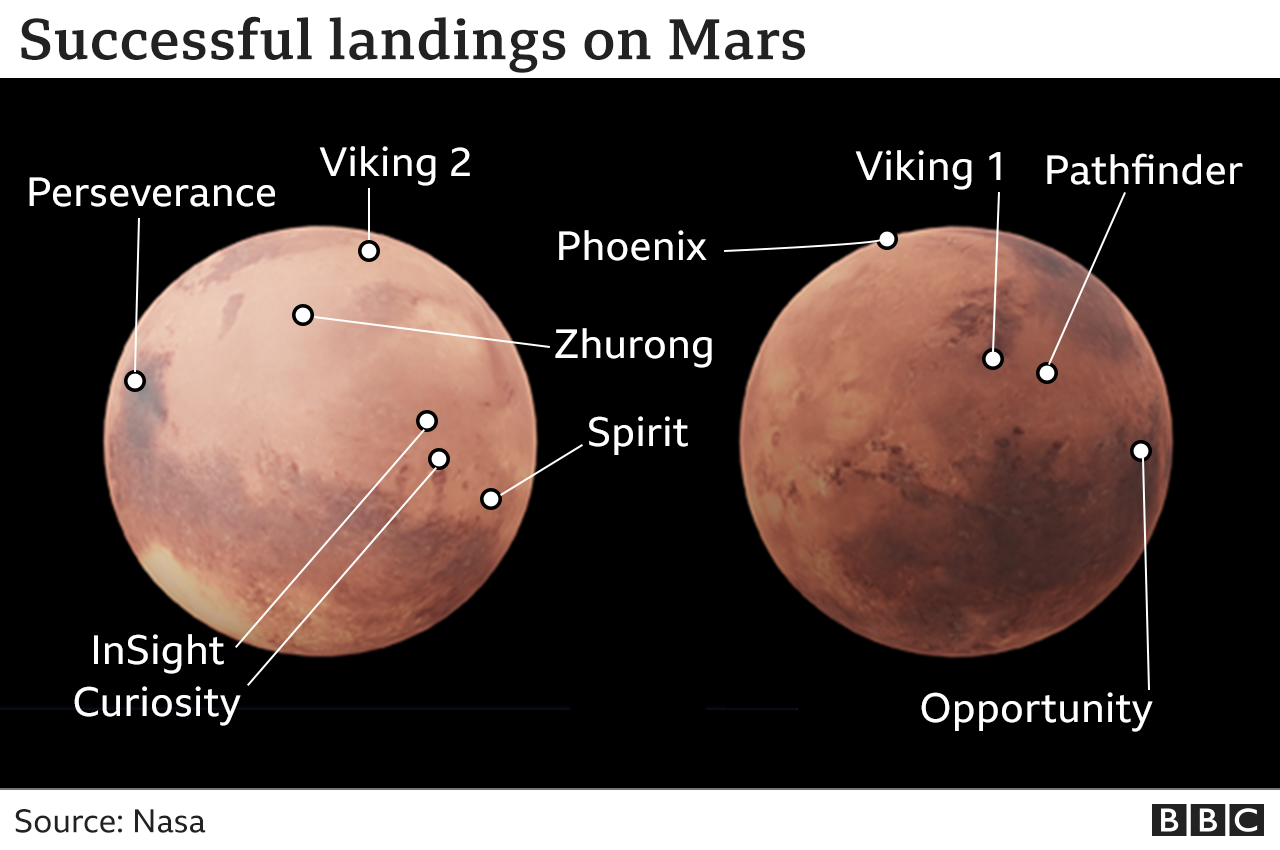
The China National Space Administration (CNSA) on Sunday released new videos and photos captured by the country's first Mars probe Tianwen-1 during its landing and roving exploration on the red planet.
The Tianwen-1 mission was launched on July 23, 2020.
On May 15, 2021, the lander finally touched down in the southern part of Utopia Planitia, a vast plain in the northern hemisphere of Mars. A week later, Zhurong the rover started its exploration of the red planet, making China the second country after the United States to land and operate a rover on Mars.
On Sunday, four video clips were released for the first time. The first, captured on May 15, recorded the descent and landing process of the lander and rover. A second one showed the rover driving down from its landing platform to the Martian surface on May 22. Two more videos, shot on June 1, recorded the rover driving around and having photos taken alongside the lander.
This is the first time that videos of the rover's movements on Mars have been seen.
On June 16, the rover conducted an overall assessment of its surrounding environment to plan its paths for subsequent scientific exploration.

Panoramic view of the landing site. /CNSA
An image released by the CNSA which was taken by Zhurong's rear-view camera captured its tracks on the Martian surface.

Wheel tracks left by the Zhurong rover on the Martian surface. /CNSA
So far, the Tianwen-1 mission has been in space for 338 days. The Zhurong rover has been working for 42 Martian days – one Martian day equals one day and 37 minutes on Earth – and has traveled a total of 236 meters on the red planet.
Both the orbiter and the rover are in good working conditions, the CNSA said.
Zhurong will continue its movement, detection and scientific exploration missions as planned. Meanwhile, the orbiter will continue to operate in a relay orbit, providing relay communication for the rover's scientific exploration while conducting its own scientific detection operations.
Quelle: CGTN
+++
China’s Zhurong rover returns landing footage and sounds from Mars
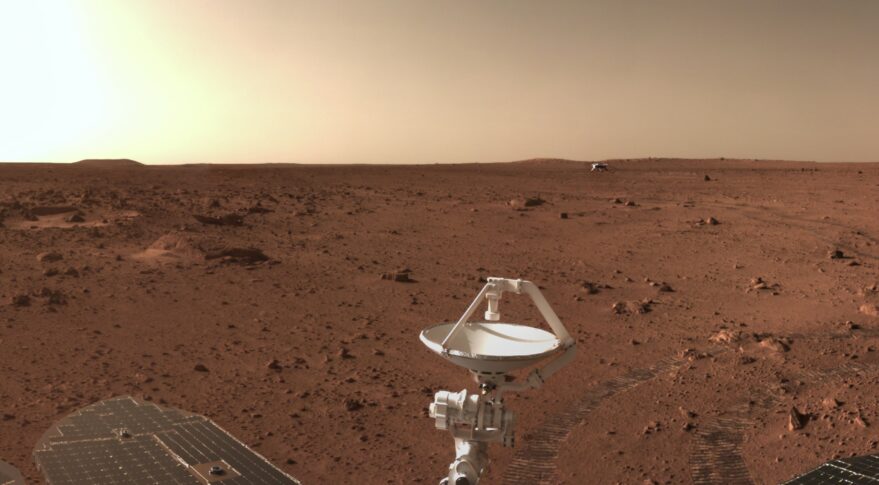
HELSINKI — China has released landing process footage from its Zhurong rover as well as video and sounds of the vehicle roving on Mars.
Footage of the entry, descent and landing shows deployment of a supersonic disk-gap-band parachute, separation of the backshell, followed by powered descent, a hazard-avoidance hover phase, and landing.
The China National Space Administration (CNSA) published the footage in a Zhurong mission update early Sunday Beijing time. Video of the descent of the Zhurong rover from its landing platform, including sounds made by the vehicle’s egress, was included in the release.
The sounds were created by the metal on metal interaction of a rack and pinion system and recorded by Zhurong’s climate station, which intends to capture sounds of Martian winds.
“With the files we released this time, including those sounds recorded when our Mars rover left the lander, we are able to conduct in-depth analysis to the environment and condition of Mars, for example, the density of the atmosphere on the Mars,” Liu Jizhong, deputy commander of China’s first Mars exploration program, told Chinese media.
NASA’s Perseverance captured similar sounds of driving on Mars in March.
The 240-kilogram Zhurong rover successfully landed in Utopia Planitia on May 14. The deployment took place late May 21 Eastern, following a week-long series of checks and analysis of the environment.
The six-wheeled, solar-powered Zhurong has since covered 236 meters on the Martian surface. An undated panorama shows Zhurong and tracks leading back to the landing platform, along with surface and horizon features.
Zhurong had earlier dropped a remote Wifi camera when still close to the landing platform. The rover then returned to pose for a joint selfie with the lander. The new update this time featured footage of Zhurong’s drive back to the landing platform and later making a turn.
“Zhurong Rover is more independent in its driving on Mars [compared with China’s Yutu lunar rovers]. It can judge by itself whether there is a path ahead based on its own image analysis. It will make a judgment about every one meter in its driving, and move towards the target set by the ground,” Jia Yang, deputy chief designer of Tianwen-1 Mars probe, told CCTV.
The rover is part of the Tianwen-1 mission, China’s first independent interplanetary mission. Consisting of an orbiter, a lander, and a rover, Tianwen-1 launched in July 2020. It entered Mars orbit Feb. 10.
Zhurong is equipped with six science payloads, including a laser-induced breakdown spectroscopy instrument for analysing surface elements and minerals, panoramic and multispectral imagers, a climate station, magnetometer and a ground-penetrating radar.
It aims to return data on potential water-ice deposits, weather, topography and geology, complementing science carried out by missions from other space agencies.
The Tianwen-1 orbiter is currently in an 8.2-hour orbit, allowing a pass over Utopia Planitia once per sol to perform a data relay role. Zhurong has a primary mission and design lifetime of 90 sols (92 Earth days). It is currently unknown if Zhurong’s mission will be extended beyond this.
Tianwen-1 carries seven science payloads. It is expected to change to its dedicated science orbit with a period of 7.8 hours after supporting Zhurong.
The Tianwen-1 mission builds on technologies and capabilities developed through the Chang’e lunar program orbiters, lander and rovers. It also draws on head shielding and parachute expertise from Shenzhou human spaceflight endeavors.
Meanwhile NASA’s Mars Reconnaissance Orbiter revealed Zhurong’s progress with images captured with the HiRise camera June 6 and June 11. The images provided evidence of Zhruong’s driving activity in absence of regular updates from CNSA.
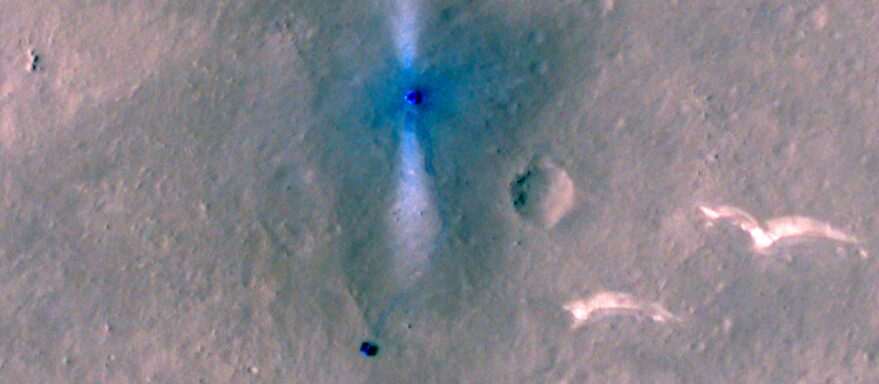
Quelle: SN
----
Update: 13.07.2021
.
China's Mars rover travels over 400 meters
China's Mars rover Zhurong has traveled more than 400 meters on the surface of the red planet, according to the Lunar Exploration and Space Program Center of the China National Space Administration on Monday.
The orbiter of Tianwen-1 mission has worked normally in orbit for 353 days as of 8:00 p.m. Sunday (Beijing Time). The distance between Earth and Mars is 370.7 million km.
The rover has traveled 410.025 meters and worked normally, the center said.
China's Tianwen-1 mission, consisting of an orbiter, a lander, and a rover, was launched on July 23, 2020. The lander carrying the rover touched down in the southern part of Utopia Planitia, a vast plain in the northern hemisphere of Mars, on May 15. Enditem
Quelle: Xinhua
----
Update: 17.07.2021
.
China's Mars rover Zhurong just found its parachute and backshell

China's Mars rover Zhurong has given us a nice close-up look at some of the vital gear it used to land safely on the Red Planet in May.
On Monday (July 12), Zhurong rolled up to investigate its parachute and backshell, which fell to the red dirt a short distance away from the rover's landing site on the huge Martian plain Utopia Planitia.
Zhurong captured black-and-white images of the gear with its hazard-avoidance cameras, including one shot that also features the rover's own tracks. And the robot snapped a stunning color photo of the parachute-backshell assembly as well. (The backshell covered the rover and its lander on its way to Mars, and through much of the planet's atmosphere.)
"The complete back cover structure after aerodynamic ablation, the attitude control engine diversion hole on the back cover is clearly identifiable," Chinese space officials wrote in a description of the image on Thursday (July 15).
When it took the color photo, Zhurong was about 100 feet (30 meters) from the back shell and roughly 1,150 feet (350 m) from its landing site, the officials added.
Zhurong is part of Tianwen 1, China's first fully homegrown Mars mission. Tianwen 1 launched in July 2020 and arrived in orbit around the Red Planet this past February, about a week before NASA's Perseverance rover made it to Mars.

In mid-May, Zhurong separated from the Tianwen 1 orbiter and touched down on Mars, making China just the second nation, after the U.S., to successfully land a robot on the Martian surface and operate it for an appreciable length of time. (The Soviet Union's Mars 3 spacecraft landed successfully in 1971 but died about two minutes later. And the European Space Agency's Beagle 2 lander may have touched down safely in December 2003, but it never made contact with its handlers.)
Zhurong is studying the geology and topography of its surroundings and hunting for buried water ice, among other tasks, during a surface mission designed to last at least 90 Mars days, or sols (about 93 Earth days). The Tianwen 1 orbiter, which relays communications to and from Zhurong in addition to performing its own observations, will operate for at least one Mars year (687 Earth days), if all goes according to plan.

As of Thursday, Zhurong has been exploring the Martian surface for 60 sols and has traveled a total of 1,476 feet (450 m), Chinese officials wrote in the image description.
This isn't the first time that a Mars rover has inspected its own entry, descent and landing hardware. For example, NASA's Opportunity rover gave us a similar shot in December 2004, nearly a year after it touched down.
Quelle: SC
----
Update: 19.07.2021
.
China's Mars rover travels over 509 meters on red planet
China's Mars rover Zhurong has traveled more than 509 meters on the surface of the red planet as of 11 p.m. Saturday, according to the Lunar Exploration and Space Program Center of the China National Space Administration.
The rover will soon arrive at the second sand dune on its journey on the red planet. It will carry out a detailed survey of the dune and surrounding environment, said the administration.
As of Saturday, Zhurong has been operating on the surface of Mars for 63 Martian days. A Martian day is approximately 40 minutes longer than a day on Earth.
China's Tianwen-1 spacecraft, consisting of an orbiter, a lander and a rover, was launched on July 23, 2020. The lander carrying the rover touched down in the southern part of Utopia Planitia, a vast plain in the northern hemisphere of Mars, on May 15.
About 375 million km away from Earth, the orbiter of Tianwen-1 has operated in orbit for 359 days as of Saturday. The delay of its one-way communication was around 21 minutes.
Both the Mars rover Zhurong and Tianwen-1 spacecraft are working in normal conditions, with their subsystems operating normally, according to the administration. Enditem
Quelle: Xinhua
----
Update: 6.08.2021
,
China's Mars rover travels over 800 meters on red planet
China's Mars rover Zhurong has traveled more than 800 meters on the surface of the red planet as of Friday, according to the Lunar Exploration and Space Program Center of the China National Space Administration.
Zhurong has been traversing a complex terrain full of rocks, craters and dunes, and its rear hazard-avoidance camera captured a picture of the rover just moving across the rocks.
As of August 6, 2021, the rover has worked on the surface of Mars for 82 Martian days and the orbiter has been in orbit for 379 days. The two are in good condition and functioning properly.
A Martian day is approximately 40 minutes longer than a day on Earth. Enditem
Quelle: Xinhua
----
Update: 19.08.2021
.
China's Mars rover accomplishes planned exploration tasks
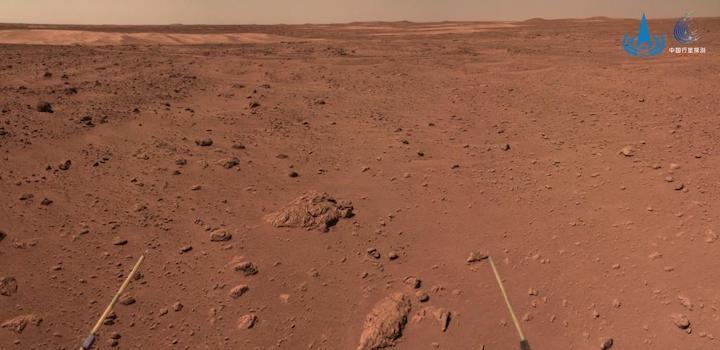
Photo released by the China National Space Administration (CNSA) shows an image taken by the navigation terrain camera onboard the rover Zhurong. China's Mars rover Zhurong has accomplished its exploration and detection tasks as planned, according to the China National Space Administration (CNSA) on Tuesday. As of Aug. 15, 2021, Zhurong had worked on the surface of Mars for 90 Martian days, or about 92 days on Earth, with all scientific payloads having started to work on detection tasks, said the administration. The CNSA added that the rover will continue to move to the boundary zone between the ancient sea and the ancient land in the southern part of Utopia Planitia, and will carry out additional tasks. (CNSA/Handout via Xinhua)
China's Mars rover Zhurong has accomplished its exploration and detection tasks as planned, according to the China National Space Administration (CNSA) on Tuesday.
As of Aug. 15, 2021, Zhurong had worked on the surface of Mars for 90 Martian days, or about 92 days on Earth, with all scientific payloads having started to work on detection tasks, said the administration.
The rover has traveled 889 meters as of Aug. 15, and its scientific payloads have collected about 10 Gb of raw data. Now the rover runs stably and operates in good condition with sufficient energy.
The CNSA added that the rover will continue to move to the boundary zone between the ancient sea and the ancient land in the southern part of Utopia Planitia and will carry out additional tasks.
According to the administration, Zhurong operated with a cycle of seven days during its exploration and detection. Its navigation terrain camera obtained topographic data along the way to support the rover's path planning and detection target selection.
Zhurong's subsurface detection radar acquired the data of the layered structure below the Martian surface, which analyzes the shallow surface structure and explores the possible underground water and ice.
The surface magnetic field detector obtained local magnetic field data and cooperated with the magnetometer in the orbiter to explore the evolution process of the Mars magnetic field.
The CNSA said the data collected by seven scientific payloads aboard the rover have been processed and verified. Chinese research teams can apply to China's Lunar and Deep Space Exploration, an organization operated by CNSA's Lunar Exploration and Space Program Center.
The data will be released monthly, the CNSA added.
China's Tianwen-1 mission, consisting of an orbiter, a lander, and a rover, was launched on July 23, 2020.
The lander, carrying the rover with an expected lifespan of at least 90 Martian days or about three months on Earth, touched down in the southern part of Utopia Planitia, a vast plain in the northern hemisphere of Mars, on May 15.
Zhurong drove down from its landing platform to the Martian surface on May 22, starting its exploration of the red planet. Enditem
Quelle: Xinhua
----
Update: 23.08.2021
.
China's Mars rover completes primary mission, continues to explore red planet
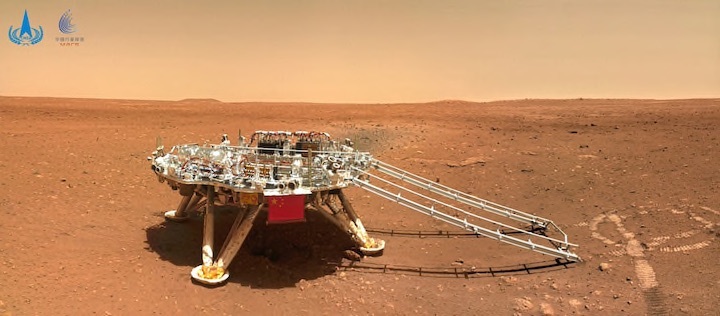
BEIJING — China’s Zhurong Mars rover is soldiering on after completing its initial program to explore the red planet and search for frozen water that could provide clues as to whether it once supported life.
China’s National Space Administration said on its website Friday that Zhurong completed its 90-day program on Aug. 15 and was in excellent technical condition and fully charged.
It said it would continue to explore the area known as Utopia Planitia where it landed on May 14. Zhurong has been consistently sending back photos and data via the Tianwen-1 orbiter that crosses over it once a day.
After the United States, China is the second country to land and sustainably operate a spacecraft on Mars, where days are 40 minutes longer than on Earth.
At 1.85 meters (6 feet) in height, Zhurong is significantly smaller than the American Perseverance rover, which is exploring the planet with a tiny helicopter. NASA expects its rover to collect its first sample in July for return to Earth as early as 2031.
Concurrently, China is assembling its permanent space station, with three astronauts now aboard the Tianhe, or Heavenly Harmony, core that was put into orbit on April 29. Two of the astronauts completed their second space walk on Friday. All three are due to return to Earth in September and be replaced by a new crew.
China earlier launched two smaller experimental space stations. It has been excluded from the International Space Station largely at the insistence of the United States, which is wary of the Chinese space program's secrecy and close military links. Congressional approval is also required for any cooperation between NASA and the CNSA.
China also recently brought back lunar samples, the first by any country’s space program since the 1970s, and has landed a probe and rover on the moon’s less explored far side.
China first put an astronaut into orbit in 2003, becoming just the third country to do so.
Quelle: CNBC
----
Update: 1.09.2021
.
China's Mars rover completes 100 days on red planet's surface

Image taken by China's Mars rover Zhurong shows the panorama of the site. China's Mars rover Zhurong has spent 100 days exploring the red planet's surface since it first set its wheels on Martian soil on May 22, according to the China National Space Administration (CNSA) on Monday. (CNSA/Handout via Xinhua)
China's Mars rover Zhurong has spent 100 days exploring the red planet's surface since it first set its wheels on Martian soil on May 22, according to the China National Space Administration (CNSA) on Monday.
The rover is part of China's Tianwen-1 mission that also consists of an orbiter and a lander. The mission was launched on July 23, 2020.
As of Monday, Zhurong has traveled 1,064 meters on the surface of Mars, while the orbiter has been in orbit for 403 days. The two are in good condition and functioning properly, according to the CNSA.
The probes will experience a sun outage in mid-to-late September when the Sun is aligned with Earth and Mars, with the solar radiation interfering with the communication between the probes and ground stations.
The orbiter and rover will stop working until the sun outage comes to an end, says the CNSA. Enditem
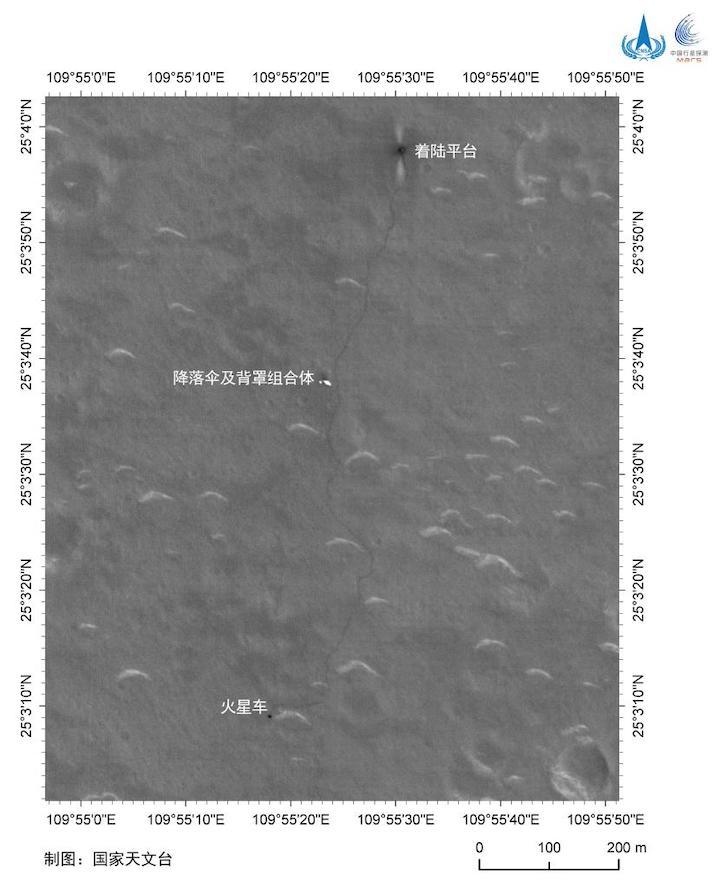
Image shows the route of China's Mars rover Zhurong. China's Mars rover Zhurong has spent 100 days exploring the red planet's surface since it first set its wheels on Martian soil on May 22, according to the China National Space Administration

Image shows the road map of China's Mars rover Zhurong. China's Mars rover Zhurong has spent 100 days exploring the red planet's surface since it first set its wheels on Martian soil on May 22, according to the China National Space Administration

Photo shows a set of commemorative coins celebrating the success of China's first Mars mission issued by the country's central bank. China's Mars rover Zhurong has spent 100 days exploring the red planet's surface since it first set its wheels on Martian soil on May 22, according to the China National Space Administration (CNSA) on Monday.
Quelle: Xinhua
----
Update: 23.10.2021
.
China's Mars orbiter resumes communications with Earth after solar conjunction
China's Mars orbiter has resumed communications with Earth after the solar conjunction and will start remote sensing of Mars in early November, the China National Space Administration (CNSA) said Friday.
The orbiter was in normal condition during the solar conjunction, said the CNSA, citing telemetry data. It is the first time that the orbiter successfully survived the solar conjunction, the CNSA added.
A solar conjunction refers to a phenomenon when Mars and Earth move to either side of the sun and the three are almost perfectly aligned. During this period, the solar electromagnetic radiation will increase, and disrupt and even jam the communications between the Mars probes and Earth.
According to the CNSA, the orbiter will enter the remote-sensing orbit of Mars in early November to carry out global detection and obtain scientific data such as morphology and geological structure, surface material composition and soil type distribution, atmospheric ionosphere, and space environment of Mars.
The orbiter will also relay the communication between the rover and Earth for the rover's extended mission, the CNSA added.
China's Tianwen-1 mission, consisting of an orbiter, a lander and a rover, was launched on July 23, 2020. The rover Zhurong drove down from its landing platform to the Martian surface on May 22, 2021. Enditem
Quelle: Xinhua
----
Update: 27.10.2021
.
China Focus: After solar conjunction, China's Mars rover Zhurong continues adventures
China's first Mars rover Zhurong, which lost contact with Earth for about a month during the solar conjunction, has sent back a signal from a distance of 400 million km stating that it is in a normal condition.
During the solar conjunction, when Mars and Earth move to either side of the Sun and the three are almost perfectly aligned, the solar electromagnetic radiation increases, disrupting and even jamming the communications between the Mars probes and Earth.
ADVENTUROUS ROVER
The design team cared about Zhurong just like people care about a child who has gone away to summer camp, said Jin Shengyi, the deputy chief designer for teleoperation subsystem of Zhurong from the China Academy of Space Technology (CAST).
"We cared about Zhurong, but we have full confidence in it. When we designed it, we took all possible situations into account," said Jin.
Chen Baichao, the chief designer of Zhurong from CAST, said it would be very difficult to keep a spacecraft in a normal condition for such a long time without ground control. But Zhurong has autonomous systems designed to cope with the solar conjunction and winter on Mars.
According to Chen, the rover has traveled more than 1,000 meters since it landed on Mars at the southern part of Utopia Planitia in May 2021. After the solar conjunction, it will head south to find mud volcanoes, which scientists are interested in, located about 10 km away.
Before Zhurong, five American rovers had landed on Mars. Although a latecomer, Zhurong has a unique innovation: it is the first Mars rover equipped with active suspension.
The idea of active suspension came from Chen, who has a background in ground vehicle engineering.
"Mars has a complex terrain with soft sand and rocks all over it, and we are worried that the rover will sink in the sand. Active suspension allows the rover to crawl out of a trap like a worm. It can also walk sideways like a crab, flexibly avoid obstacles and climb slopes at steep angles," said Chen.
With a height of 1.85 meters and a weight of 240 kg, Zhurong can travel at a speed of 200 meters per hour on Mars, which is similar to that of China's lunar rover Yutu-2. But Zhurong has traveled more than 1,000 meters in over three months, faster than Yutu-2 has done in two years.
"Zhurong, with a good memory, is more capable and more reliable. It can endure both cold and hot environments, so it can travel faster and farther," said Chen.
Originally, ground control made a plan for Zhurong to conduct environment perception, scientific detection and movement tasks over a three-day cycle. However, this was later changed to a one-day cycle. Zhurong has so far remained stable and executed the orders well.
In the eyes of Jia Yang, deputy chief designer of the Tianwen-1 probe from CAST, the rover is like an adventurous boy who is working diligently to get more results before the Martian winter.
Mars is far away from Earth, and the one-way communication between the rover and ground control takes about 20 minutes. So ground control is not able to implement timely operation of the rover.
The designers gave Zhurong the ability to deal with complex problems autonomously. As a smart rover, it only communicates with Earth once or twice a day. It can plan its own path and avoid obstacles, and can decide when to sleep and wake up, depending on environmental changes.
"Communication between the rover and the orbiter starts when the orbiter flies over the rover, so timing is very important. If space particles cause malfunctions of the rover's onboard computer, it will disturb the rover's time system," said Jia.
"We designed a set of algorithms for Zhurong to calculate time based on the trajectory of sunlight, just like survival in the wild."
SURVIVING ON MARS
Strong winds, rocky surfaces and sand storms -- the environment on Mars is much harsher than that on Earth. However, the designers have optimized the rover's ability to survive in the Martian environment.
According to Jia, the accumulation of Martian dust on the solar wings of the rover can affect the efficiency of power generation. "Due to the special design of the solar wings, the dust falling on them will be easily blown away by the wind, just like drops of water blown from the leaves of a lotus," he said.
Chen Baichao said the initial design of Zhurong featured only two solar wings. The designers wanted larger solar panels and they brought out more than 10 solutions, such as bat-like folding wings and flexible solar wings.
Chen was inspired by the wings of blue morpho butterfly, and decided to design the rover's wings like those of a butterfly, unfolding in two stages.
The designers also installed a heat-collecting device on the top of Zhurong, the first of its kind used in a rover, to keep it warm at night.
The device uses a chemical called n-undecane to store heat energy. During the day, the substance absorbs heat and melts, and when the temperature drops at night, it releases heat in the process of solidification to keep the rover warm.
The light on Mars is another challenge. "The light is unstable on Mars, and there is scattered light. We had no idea how much it would contribute to solar-wing power generation," said Chen.
After a year of experimenting and research, the designers established a theoretical model of solar-power generation on Mars. Now they can infer weather conditions on the planet from this model.
CHINESE FOOTPRINTS
Zhurong has left Chinese footprints in the sand of the red planet. Inscribed on the surface of the rover's rear wheels is the Chinese character "Zhong" -- the first character of the word Zhongguo, which means China. The character "Zhong" is imprinted in the two ruts made by the rover as it travels across the surface of Mars.
"We carved Zhong on the wheel surfaces not just for symbolic purposes, but also for technical reasons. We can measure the slip ratio of the rover by the distance between the Zhong characters," said Jia.
The circumference of the wheel is one meter. If the distance between the Zhong characters is one meter, it indicates that the rover is running normally. If the distance is obviously shorter, it means that the rover is skidding and may sink in the sand.
"When we designed the rover, we did a lot of brainstorming to learn from every way of thinking. We want not only a powerful rover that can work normally on the surface of Mars, but also a beautiful rover that can represent the highest level of Chinese space engineering."
After the rover was completed, the designers wanted to use Chinese cultural elements to make it more beautiful. The artist Su Dabao created a pattern featuring the Chinese character "fire" using a combination of Chinese calligraphy and seal cutting. The decorative pattern was installed on the "head" of the rover before it was launched.
"Zhurong gives us a Martian view of our solar system, a deeper understanding of the universe, and has inspired us to ponder the old questions: Who am I? Where do I come from? Where will I go?" said Jia. Enditem
Quelle: Xinhua
----
Update: 1.12.2021
.
China’s Mars rover has amassed reams of novel geological data
A second study2, published in August, used high-resolution images from the orbiter to pinpoint the rover’s precise coordinates on Mars. But researchers say that many more studies are expected soon, including some on the region’s topography.
So far, the data has been shared only with researchers directly involved with the mission, but Wu says that the NAOC will at some point release them to the public and the international community.
That could help to speed up the analysis. Scientists with more experience of Mars might be able to recognize features of interest and their significance more quickly, says Flannery. “Mars is peculiar in some ways, and geologists are only as good as the rocks they have seen in the past,” he adds.
Next phase of the mission
Zhurong will now continue to explore, potentially for years, as some of NASA’s Mars rovers have.
Tianwen-1 has also been busy. The spacecraft recently adjusted its orbit and switched from acting mainly as a communications relay between Zhurong and Earth to also conducting its own observations of Mars. Wenzhe Fa, a planetary scientist at Peking University, Beijing, who is analysing Zhurong’s radar data, says that on 11 November, the CNSA deployed and began to test the antenna for the orbiter’s radar.
Also earlier this month, the CNSA and the European Space Agency (ESA) trialled whether the ESA’s Mars Express orbiter could be used to relay Zhurong’s data to Earth — an exercise that Pan says is an “amazing step” towards increased international collaboration with China.
As Zhurong resumes its journey, Bo says that he and his team are providing “suggestions for future data collection” that take in surface features of particular scientific interest.
Quelle: nature




